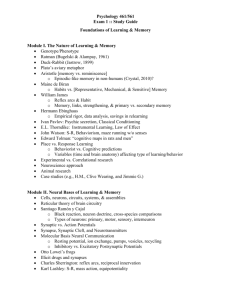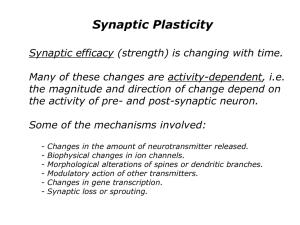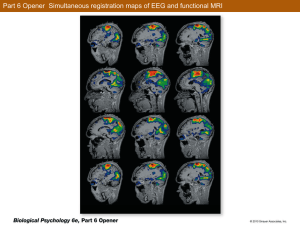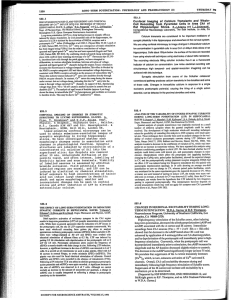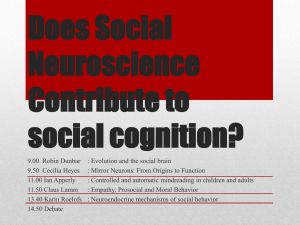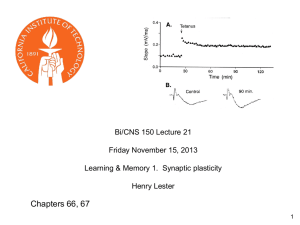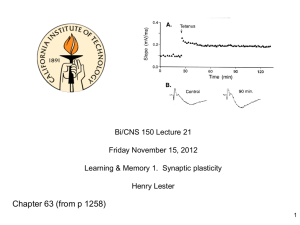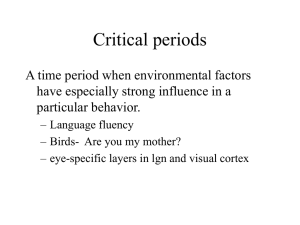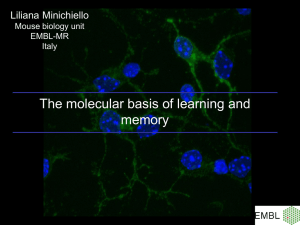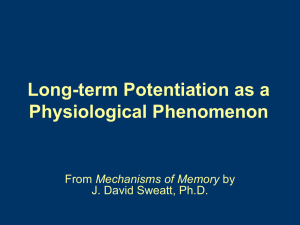A primer to LTP
advertisement
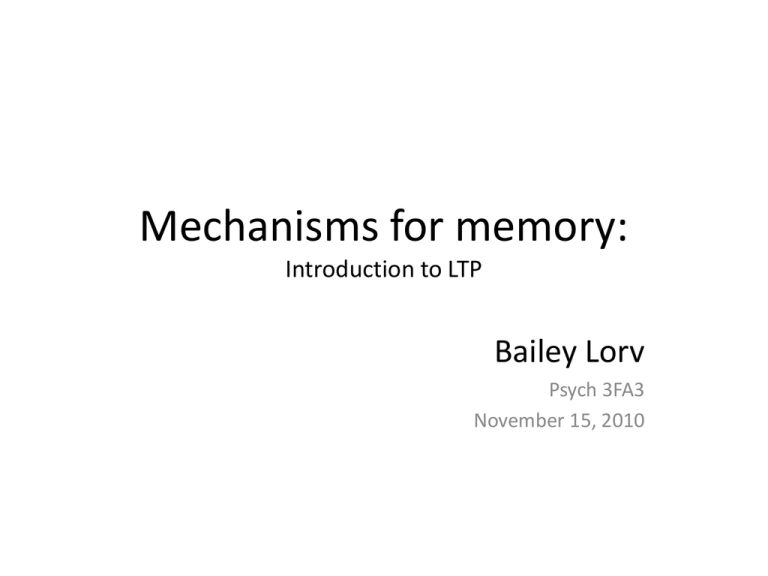
Mechanisms for memory: Introduction to LTP Bailey Lorv Psych 3FA3 November 15, 2010 Lecture Outline • Synaptic Plasticity • Long-term Potentiation – Cellular level – Molecular level – As a mechanism for memory • Long-term Depression • Behavioural Correlates and Closing Remarks Synaptic Plasticity Learning as a change in synaptic strength Short Term Synaptic Plasticity • Facilitation – Ca2+ abundance • Synaptic Depression – Neurotransmitter depletion • Post-tetanic potentiation Hebb’s Postulate When an axon of cell A is near enough to excite cell B or repeatedly or persistently takes part in firing it, some growth process or metabolic change takes place in one or both cells such that A's efficiency, as one of the cells firing B, is increased. • Cells that fire together, wire together Long-Term Potentiation • Long-term facilitation of synaptic activity • Characterized by Bliss and Lomo (1973) • A persistent (several hours +) increase in strength and ease of post-synaptic activation induced by frequent high intensity electrical activity (tetanus) in the pre-synaptic neuron The Hippocampus • Involved in spatial memory, formation of declarative memory • CA1 damage has led to memory deficits in humans (Zola Morgan et al., 1986) • Relatively easy to isolate intrinsic connections Rat Hippocampal Anatomy Perforant Pathway Entorhinal cortex to granule cells of dendate gyrus Mossy Fiber Pathway Granule cells of dendate gyrus to pyramidal cells of CA3 Schaffer Collateral Pathway Pyramidal cells of CA3 to pyramidal cells of CA1 Recording Setup Bliss and Lomo (1973) Results Baseline activation Inducing LTP 1) Tetanus (Nicoll, Malenka and Kauer, 1988) Fig 23.3 from Neuroscience, edited by Purves 2) Pairing pre-synaptic and post-synaptic (Gustafsson et al., 1987) • Single shock, not strong enough to induce LTP • Pair (within 100 ms) with depolarizing current in cell body From Ch 23: Neuroscience, edited by Purves Fig 23.4 from Neuroscience, edited by Purves Molecular Mechanisms of Change • In area C1, LTP occurs in glutamate releasing synapses – Glutamate antagonists (AP5) block LTP • 2 types of glutamate receptors – NMDA-R: Ca2+ channel • Channel blocked by Mg2+ – Non-NMDA-R (AMPA-R): Na+ channel • In order to free the NMDA-channel pre-synaptic: glutamate release post-synaptic: Mg2+ release, via depolarization • Coincident detector Fig 3.3 from Cognitive Neuroscience of Memory, by Eichenbaum A. Prior to depolarization B. After depolarization • Ca2+ -> activation of protein kinase or activation of calmodulin-dependent protein kinase 1) Increase sensitivity of post-synaptic neuron 1. Activate cAMP responsive element-binding protein (CREB) 2. CREB leads to transcription (mRNA) of immediate early genes (IEGs) which regulate the expression of particular late effector genes (LEGs) 3. Synthesis of proteins such as AMPA-R 4. Insert receptors into cell membrane From Ch 3: Cognitive Neuroscience of Memory, by Eichenbaum 2) Using retrograde factors (i.e. NO, arachidonic acid) -> enhances pre-synaptic release – Unknown mechanism • Both result in increased excitation of postsynaptic following stimulation of pre-synaptic From Ch 3: Cognitive Neuroscience of Memory, by Eichenbaum Why LTP may be a mechanism for memory 1) Important component of hippocampus 2) Develops very quickly -> Can occur as quickly as 1 min after a stimulus train 3) Persistent -> Is long lasting even in in vivo preparations From Ch 3: Cognitive Neuroscience of Memory, by Eichenbaum 4) Specificity • Strengthening of only the synapse which shows coincidental activity Depolarization of post-synaptic Glutamate release 5) Associativity • Pairing of a strong and weak stimulus • Why? Fig 3.2 from Cognitive Neuroscience of Memory, by Eichenbaum Long-term Depression • Maximal efficacy problem • Epilepsy • Stimulate Schaffer collateral pathways at a low rate (1 Hz) for a long period of time (10-15 minutes) – Can reverse LTP – Decrease activation following stimulation • Same mechanisms as LTP – NMDA-R – High versus low rate of increase in Ca2+ • High rate of increase in Ca2+ -> – Activation of calcium dependent protein kinase, CaMKII -> phosphorylation of target proteins From Ch 23: Neuroscience, edited by Purves Ca2+ • Low rate of increase in Ca2+ -> – leads to activation of phosphotases -> removes phosphate groups from target proteins • Phosphatase blockers inhibits formation of LTD From Ch 23: Neuroscience, edited by Purves Removal of NMDA-R From Lau and Zukin, 2007 Closing remarks on LTP • Artificial phenomenon... • Ubiquitous Process • Potential mechanism for memory? – – – – Enriched versus impoverished environments Effects of training (Module 8) Chemical inhibitors affects learning (Module 7) Saturation can block learning

